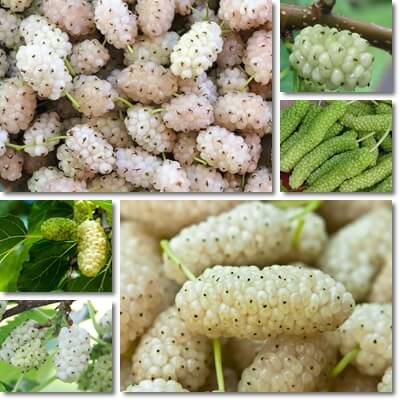White mulberries are a healthy seasonal summer fruit and the first of all mulberry colors to ripen. Perfectly safe to eat raw, cooked and otherwise processed, white mulberries are a good source of nutrition and full of benefits for health. But the newly rediscovered fruit is still enshrouded in mystery. Read below 13 interesting facts about white mulberries to give you a better idea of what a white mulberry is.
1- White mulberries are related to figs and jackfruit
White mulberries are a botanical and culinary fruit, and related to figs. Both mulberries and figs belong to the botanical family Moraceae, colloquially known as the mulberry family or the fig family (the choice of common name depends on the speaker and the fruit they are more familiar with). White mulberries are also related to breadfruit, jackfruit and Osage orange.

2- White mulberries refers to both the fruit and the tree species
The name ‘white mulberry’ is an informal denomination used in colloquial language to refer to both mulberry fruits that are white when ripe and specific species of mulberry that produce white fruit, and fruit of different colors. White mulberries, as in white mulberry species, have fruit that are white, white with a mauve or lavender tinge, pink, deep red, purple-black and black.
To make matters even more confusing, there is also a separate species of mulberry called the black mulberry which produces black mulberry fruit that look like black mulberries produced by the white mulberry species.
3- White mulberry flowers don’t look like actual flowers
One of the particularities of white mulberries is the appearance of the flowers they come from. White mulberries come from inconspicuous flowers botanically known as catkins. Catkins are unusual looking flowers in the sense that they are elongated, relatively slim and cylindrical in shape, with a light, muted green color that camouflages them wonderfully behind the leaves. Also, white mulberry flowers are actually a compilation of dozens of botanical flowers.
4- There is more than one type of white mulberry fruit
When it comes to white mulberries, know that there are actually two different types of the fruit.
- a shorter and plumper variety of white mulberry produced by the species called simply ‘white mulberry’ (scientific name: Morus alba)
- a longer, rope-like variety of white mulberry produced by the species called the king white mulberry or long mulberry (scientific name: Morus macroura)
Is one variety of white mulberry edible and the other poisonous? Find out which types of white mulberry you can eat.

5- White mulberries are not real berries
Despite their name, white mulberries are not real berries, as in botanical berries. Why the name? White mulberries look like other fruits called berries in familiar language e.g. raspberries, blackberries, strawberries.
However, not even raspberries, blackberries and strawberries are real berries – they are aggregate fruit. Bananas are real berries. Tomatoes, cucumber and eggplant are also real berries.
White mulberries and other mulberry colors are, in fact, composite fruit or multiple fruit or aggregate fruit, that is, several botanical fruit all merged into one larger piece of fruit. Pineapple, noni and jackfruit are also multiple fruit, just like white mulberries.
6- White mulberries are a true organic fruit
There is a lot of interest nowadays in clean eating and organic food represents the foundation of clean eating. However, most, if not all of the foods available commercially and certified organic are not actually 100% organic.
Usually, pesticides, insecticides and other similar toxic chemical products are used on organic crops, but either in lower amounts, or only new-generation products that are deemed less toxic for wildlife and the environment.
But white mulberries are extremely fragile fruit: they are highly perishable which implies too big a cost for harvesting, storage and transportation. They are simply not commercially desirable so most of the times they are sourced from the wild in very small amounts, often times, by the end consumers themselves (white mulberry and other colors are invasive and enjoy a strong presence in natural environments). Given their occurrence in the wild and the lack of human intervention, the resulting fruit are a clean food, 100% organic.
7- Fresh white mulberries count as a forage fruit
Fresh white mulberries are not typically available from commercial production due to their high perishability which drives high storage costs and very low profits, if any. As a result, they have to be sourced, usually from the wild, sometimes from back gardens, and are, by definition, a forage food.
8- White mulberries are a functional food
White mulberries are classified as a function food, or nutraceutical, meaning a food that has beneficial effects on human health. Part of the benefits of white mulberries are scientifically demonstrated, whereas part are reported by consumers. Studies have identified highly biologically active constituents in white mulberries with cholesterol and blood pressure lowering effects, antidiabetic and anti-obesity activities, and anticancer properties.
9- White mulberries are a food and dietary supplement
White mulberries are either consumed as food or taken as a dietary supplement for their benefits for health. The fresh fruits are typically consumed as food, eaten by themselves as a snack or dessert, or incorporated into various dishes and meals (e.g. topping for yogurt or morning cereal, ingredient in fruit smoothies, ingredient baked sweets such as pastry products with filling, pies, cupcakes and cakes).
White mulberries are also commonly cooked, from fresh, and used to make whole fruit jam, fruit sauces, but also alcoholic beverages such as eau-de-vie, wines or liqueurs. Dried white mulberries are almost exclusively used for their therapeutic benefits and taken as a dietary supplement.
10- White mulberries have allergenic potential
One of the downsides of white mulberries is the fact they can and do cause allergic reactions. Both the fruit and the flowers are allergenic and can cause mild to severe allergic reactions with symptoms ranging from allergic rhinitis with sneezing, runny nose and red, itchy, watery eyes to anaphylactic shock.
11- White mulberries are high in vitamin C
One of the biggest benefits and advantages of eating white mulberries fresh, right off the tree if possible, is the fact they provide good amounts of vitamin C. How much vitamin C in white mulberries? A serving of 100 grams of the fresh fruit can get you 40% or more of your total daily vitamin C values.
Vitamin C is important for teeth health and keeps gums healthy, reducing risks of gum disease and tooth loss. Vitamin C has scientifically proven immunomodulating effects, actively supporting the immune system function. Getting as much as possible of your daily requirements helps lower inflammation levels in the body, and stimulates the production of collagen for antiaging benefits and faster wound healing.
12 – White mulberries have a good content of iron
How much iron in white mulberries? 100 grams of white mulberries provides close to 15% of total daily iron values for the average adult. It’s actually quite a good content of iron for a fruit.
Not just this, but white mulberries also have a good content of vitamin C to help increase the absorption of iron in the body and maximize its health benefits.
Iron is needed to produce new red blood cells and hemoglobin in red blood cells to boost vitality and energy levels. Increasing iron intake helps with tiredness and fatigue, combats muscle weakness and generalized weakness, and helps with symptoms such as irregular heartbeat.
13- White mulberries are the first of all colors to ripen
Out of all colors, white mulberries are the first to become ripe. White mulberries are typically ready to be harvested early in the summer. White mulberry season in the northern hemisphere is beginning of June to late June – early July. However, know that region, climate and yearly weather and temperature variations may cause the season to shift by a few weeks.
One great thing about white mulberries is they don’t all ripen at the exact same time. You can harvest the fruit off a tree over the course of several weeks which is a good thing because it makes it easier to plan harvesting sessions and schedule processing e.g. freeze some fruits, use a batch for making whole fruit jam or the overripe mulberries for wine or sauces.
